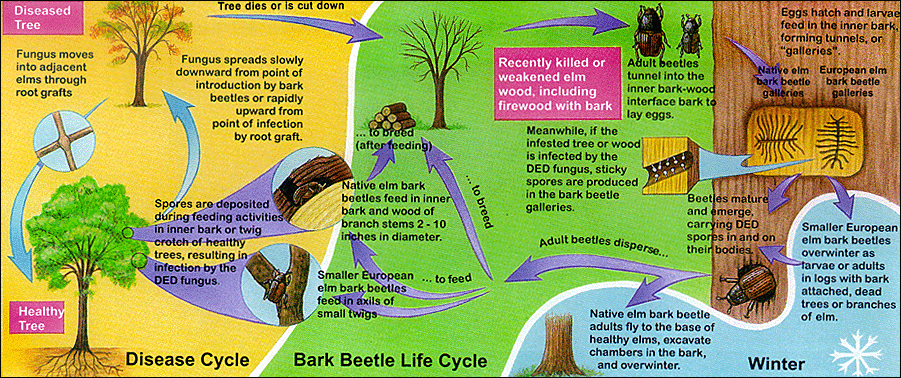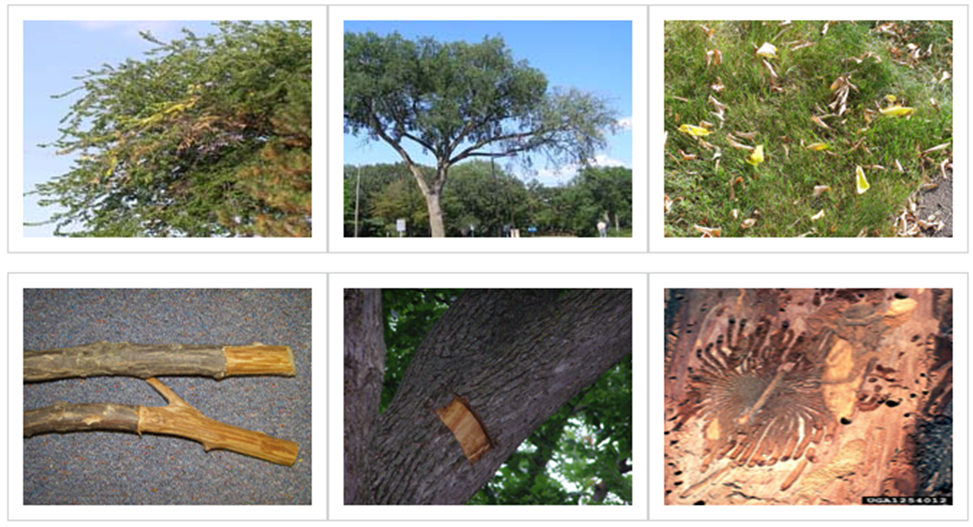Dutch Elm Disease
Dutch elm disease (DED) is a fungal disease that will infect all native Minnesota elm trees; however, the disease does not always kill the tree. The success and rate of movement within the tree depends on tree size, time and location of infection in the tree, climatic conditions and the defensive response of the tree. The fungus that causes Dutch elm disease was first introduced to Minnesota in 1961. Today, the disease can be found in every county in Minnesota yet it is estimated that 1 million elms still remain within communities.

How does Dutch elm disease happen?
Bark beetles introduce fungi to the trees. Then, the tree plugs up it xylem tissues to try and stop the fungus from spreading. This is similar to when your nose gets stuffed up when you have a cold or allergies. The plugs prevent nutrients and water from traveling up the tree, which slowly kills the tree.
What are some initial signs of Dutch elm disease?
A common sign of Dutch elm disease is when the top leaves on the top branches start to wither and fall off. You’ll notice your leaves are turning yellow or brown in the late spring or summer. Then the rest of the crown (top of tree) will slowly lose its leaves.
- Starts with a few branches
- Observed in early summer
- Brown streaks in sapwood
- No discoloration in the inner bark

What can I do to prevent Dutch elm disease?
- Pruning of weak or dying branches can be effective
- Insecticides can be somewhat effective when it comes to killing adult bark beetles
- Inject elms with fungicide. This can be expensive and it needs to be re-applied every couple of seasons
- Planting trees that are Dutch elm disease resistant
City of Thief River Falls Management of Dutch elm disease trees ─
A routine part of Thief River Falls’ efforts to maintain our urban forest is to inspect and diagnose trees for disease, and to remove those trees that are diseased or may harbor disease-carrying insects.
If a Dutch elm disease is found in trees on your property, the tree(s) will be marked with a white band. While we all hate to lose a tree, but there is a very important reason why the diseased trees must be removed promptly. Diseased Elms are a breeding site for Elm bark beetles that help spread the disease to healthy trees. Promptly removing diseased trees is still the best way to slow the spread of Dutch elm disease.
By City Ordinance, diseased trees on private property must be removed within (20) days of notification. If removal has not been done by that date, the City will have a contractor remove the tree and the property owner will be assessed the cost. The property owner will be responsible for all tree removal and disposal costs. Proper disposal shall be chipping and debarking, burning, or burying in a state-certified landfill.
If you have any questions please contact Brian Benitt, Thief River Falls City Forester, at 681-8506. Your cooperation is greatly appreciated. Thank you.

